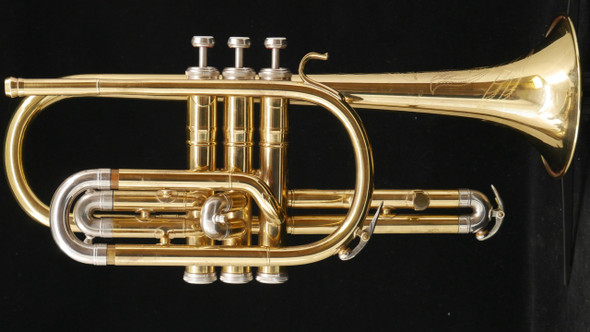Description
Beautiful Chrome C.G. Conn 38A Victor Special Cornet
This is a wonderful vintage cornet from Conn! All slides and valves move freely. It does have some signs of use. There is some wear on the finish on the 3rd valve knuckle, 2nd valve slide, 1st valve, 1st valve slide, and on the lead pipe. There is a slight dent in the bell flare and minor dents on the curve of the bell stem. The 1st Valve is also missing a knuckle and there is a small scratch on the second valve and a phone-number etched into the 2nd valve as well. Other than those small cosmetic issues, the valves move well and compression is actually very good for a horn its age. The bell has a wonderful engraving!
From the fabulous Conn Loyalist:
This is the C.G. Conn 38A Victor Special Cornet.
Patent for this instrument was applied for on October 4, 1937, U.S. Patent number 2,146,967. Part of the patent application reads as follows: "An object of the invention is to shorten the instrument, without sacrificing any of the tone quality, by arranging the tuning slide in a complete loop, the ends of which are arranged beside each other and facing in opposite directions, instead of the U-shaped section in which the tuning slide is usually arranged, thereby adding to the length of the air column in the instrument the full width of the loop, and consequently permitting shortening the the length of the instrument somewhat for any given total length of the air column. This involves offsetting the parts of the instrument body at the base of the loop, [as explained below,] to bring them along side each other." The patent application then goes on to state the second purpose of the patent: "Another object of the invention is to speed up the adjustment of the tuning slide by utilizing and adjustment member (...) having right-and-left threaded engagement with posts mounted to extend towards across the loop from the tuning slide and from the instrument body." The upshot of all this is that as well as shortening the length of the instrument by the width of the opera glass tuning slide, turning the knob of the tuning slide will extend it twice as fast as on, for example, the 80A.
I have learned that the third slide without the finger ring to adjust the pitch of a low D and C# is slightly longer than it is on modern instruments. On modern instruments the low Eb is in tune, but the low D and C# are quite sharp. On these older cornets with the longer third slide and no finger ring the Eb is a bit flat and the D and C# are slightly sharp, but not as sharp as they are on later instruments. It was thought that the flat Eb and slightly sharp D and C# were within the abilities of the player to lip into tune.
Sold with Case, Mouthpiece, and Lyre
If you have additional questions send us an email.
Prior to ordering please check our Shipping and Returns policy.
Also note weight indicated in the ad is shipping weight not actual weight of instrument.














































